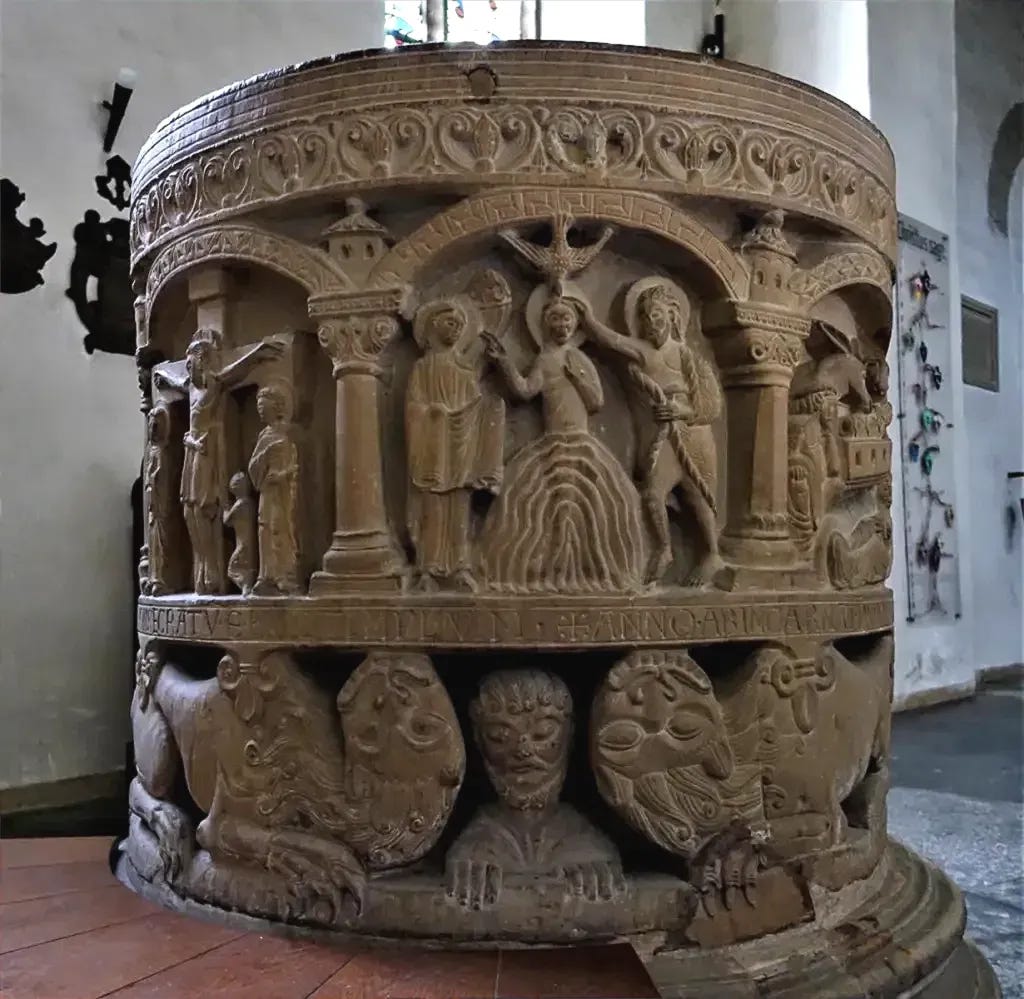
It’s undeniable that some of the most exquisitely carved and symbolically rich baptismal fonts come from the Romanesque period.1 Scholars even refer to the 12th and 13th centuries as “the Golden Age of the Baptismal Font.”2 Not only are these fonts magnificently decorated, they also offer much to ponder about both Christ’s Baptism and our own.

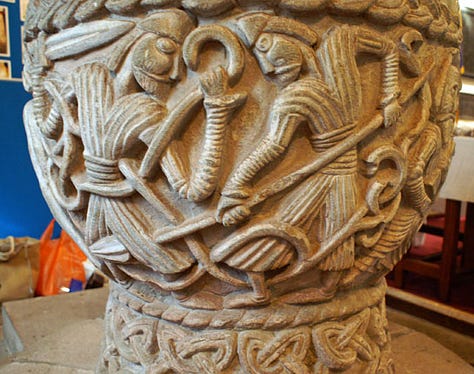

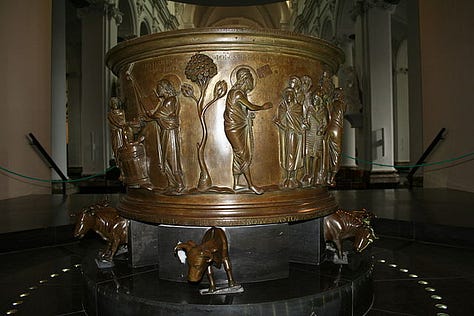
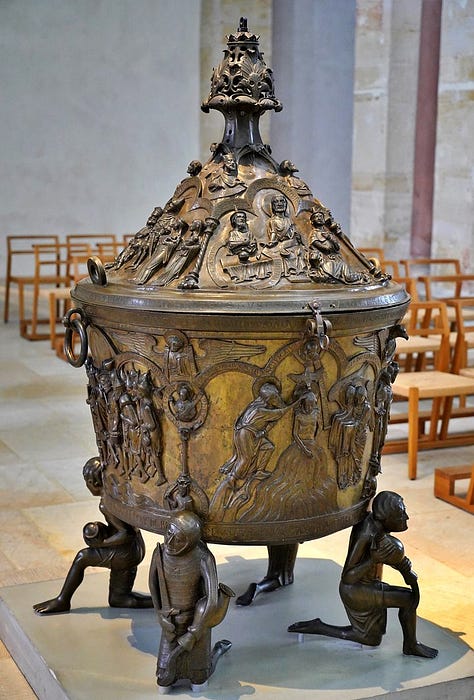

Romanesque fonts do not hide in dark corners of the church, but confront churchgoers upon entering, forcing all who wish to cross the threshold to walk around its great basin.3 Moreover, the large carvings which adorn the fonts demand to be seen. Usually large enough to fit a person inside, they tower forth from the stone floor of the church, boasting elaborate ornamentation and often fearsome monsters. Dragon-like lions prowl on the bottom of these fonts or sometimes hold them up. Snakes writhe amidst vegetation. Christ harrows hell, yanking Adam from the doors of Hades.
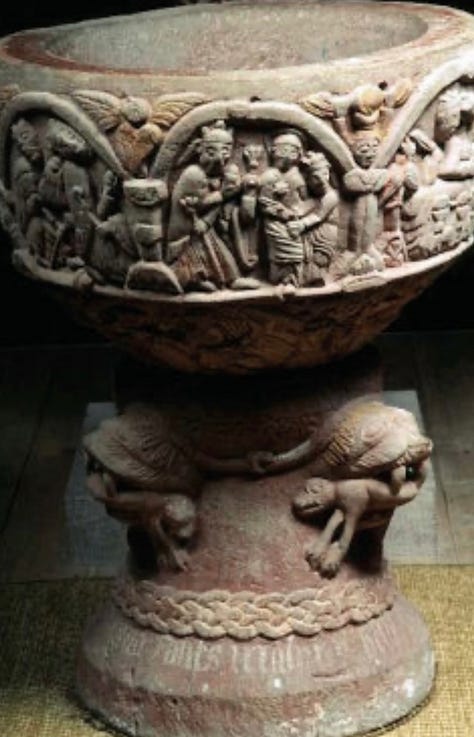




It seems odd to our modern eyes to see images of dragons or combat on baptismal fonts, but it would not be surprising for a twelfth century Christian living in a more violent and war-like society. Further, with their identity fully immersed in Christendom, they knew well of the “prowling lion” in their midst. The tomb-like imagery of these fonts also would not be lost on these medieval Christians who could not ignore death even if they tried. Nor would the symbols, which were drawn from Biblical texts associated with Baptism in the liturgy and in the writings of the Church Fathers.
Saint Cyril of Jerusalem (313-386) relates how the waters which Christ descended into in Baptism, were known as the dwelling place for the sea monster, an image of the devil. He says,
The dragon Behemoth, according to Job, was in the waters, and was taking the Jordan into his gullet. But, as the heads of the dragon had to be crushed, Jesus, having descended into the waters, chained fast the strong one, so that we might gain the power to tread on scorpions and serpents. Life came so that henceforth a curb might be put on death, and so that all who have received salvation might say: O Death, where is your victory? For it is by Baptism that the sting of death is drawn. You go down into the waters, bearing your sins; but the invocation of grace, having marked your soul with its seal, will prevent your being devoured by the terrible dragon. Having gone down into the waters dead in sin, you come out brought to life in justice" 4
So in Baptism, Christ defeats the monster, liberating the soul to enter his Kingdom.
Today we will explore the 12th century font, known as “the Freckenhorst font.” This font is especially well carved and symbolically rich; however, the complex artistic scheme is not exactly unique. Many of the symbols and scenes are fairly common among Romanesque fonts of the period. Still, each detail is pregnant with meaning.5 Even the beautifully decorated columns which frame the images on the font are important, as they resemble the columns of a church building, reminding us that the sacraments are “of the Church.”6
The largest figures on this font from Germany are the three dragon-like lions which wrap around the base. Symbolically, lion imagery can be ambiguous, since Biblically they are associated with both Christ “the lion of Judah” and the devil “the prowling lion.” Here, the figure of Daniel helps us interpret their meaning, as do some relevant Psalms which have been traditionally applied to Baptism.7 The cave of Daniel points us to think of the tomb of Christ’s rebirth. As Daniel spent three days among lions, and emerged unscathed, so Christ descended into the waters of death, and then into death itself, emerging victorious.
Medieval Art Historian Harriet Somme’s de Torrens explains why lions were so common on baptismal fonts:
Hundreds of Romanesque baptismal fonts include representations of lions, many of which in some way symbolize the struggle between the soul of man and Satan, a key component of the scrutinies performed in the baptismal liturgy where the grip of Satan on the unbaptized soul is exorcized prior to the rite of baptism.8
Thus, the dragon-like symbols serve as reminders of the crucial importance of the exorcisms in the Baptismal rite.
In addition to the lions, there are seven scenes carved into this large circular font which serve to illuminate the rich meaning and significance of baptism. Below, I will use quotes from Church Fathers to help explain the relationship of these images from the life of Christ to Baptism.9
The Annunciation
Countless Church Fathers speak of the waters of Baptism as “the womb and the tomb.”10 In light of this, the image of the Annunciation on this baptismal font begins to make sense.
Saint Leo the Great (400-461) elucidates the connection in a sermon:
To every one that is reborn the water of baptism is like the Virgin's womb. The same Holy Spirit fills the font as filled the Virgin, so that the sin which was nullified there by that sacred conception may be removed here by the mystic washing.11
In this carving, the figure of the Angel Gabriel holds his hand up in blessing and Mary opens her hands, welcoming the Holy Spirit. The figures fit together elegantly, as if pieces in a puzzle, demonstrating the fitting nature of God’s Providence.
Nativity
The next scene on the font is a simple Nativity. Only three figures and two animals are present. The Nativity and the Baptism of Christ are liturgically linked together in the Incarnation cycle, and are often linked artistically through a common setting—the cave. The image of a cave links the descent of God into human flesh and the descent of Christ into the waters of death to his descent into death and his burial. Although this particular image does not include a cave, the burial imagery is there. The Christ child is wrapped in burial cloth and lies in a coffin-like manger, reminding us that he took on death so that we may live.12 Already at his birth, Christ had descended into the place of death.
Baptism
In the next scene on the font, John the Baptist lays his hands on Christ, baptizing him. All four Gospels recount this moment in which, “the heaven was opened, and the Holy Spirit descended in a bodily form, as a dove, upon him, and a voice came out of heaven, Thou art my beloved Son; in thee I am well pleased.” (John 1:29-34)
In this image, the waters rise up and then abate as they make contact with Christ, who holds his hands out in blessing.
St. Gregory of Nyssa (335-394) explains the significance of Christ’s blessing the Jordan:
When Eliseus sent Naaman the leper to wash himself in the Jordan, and when he cleansed him from his sickness, he suggested what was to come, both by the general use of the water and by the special baptism in the river. In fact, alone among rivers, the Jordan received the first-fruits of sanctification and blessing, and poured out, like a spring, the grace of Baptism on the whole world.13
The Greek prayer for consecrating the baptismal water eloquently tells how in this event, the Holy Spirit consecrates the waters, and Christ conquers the spirits therein, foreshadowing his victory on the Cross: “Thou hast consecrated the waters of Jordan by sending thy Holy Spirit (Pneuma) from above, and thou hast trampled the head of the snake that was hidden therein.”
In the Old Testament, Joshua’s crossing over the Jordan signified the crossing into a New Kingdom. Similarly, Christ bridges the way between earth and heaven, connecting mankind, represented in this image by John the Baptist, and the Heavenly Kingdom, represented here by the angel who holds Christ’s garments. It is by crossing through the waters of Baptism that we all enter the Heavenly Promised Land. The garments held by the angel remind us of the garment the baptized receive after Baptism and recall the words from the prophet Isaiah: “He has clothed me with the garment of salvation and He has covered me with the vestment of joy” (Isaiah 61:10)
Another important element of this carving is the dove. Artistic images of the Baptism highlight the dove to emphasize the revelation of the Trinity. For in this event we see Christ, hear the voice of the Father, and see the Holy Spirit represented by the dove. The dove also recalls types of Baptism from Genesis including the creation and the story of Noah.
As St. Cyril of Jerusalem preached:
Water is a wonderful thing:-and the most beautiful of the four sensible elements of the cosmos-The sky is the dwelling of the angels, but the skies are made of water; earth is the home of men, but the earth has come out of the waters; and before the creation of visible things in six days, the Spirit of God hovered over the waters. The water is the principle of the Cosmos, and the Jordan of the Gospel.14
Therefore, just as God brought forth Creation from the waters, He brings forth the New Creation through the waters of Baptism. So, in his own Baptism, Christ paves the way for us to enter the Heavenly Kingdom.
Crucifixion
So far we have explored how Baptism is a rebirth, and a victory over evil, but it is also a death. We cannot understand our own Baptism or Christ’s without the Cross. It is fitting that this scene is the central scene of the cycle.
Here, Christ appears on the cross, stripped of his garments. In preparing for Baptism, catechumens would strip themselves of their old garments which symbolized taking off the old man, and preparing to “put on Christ.” In putting on Christ, Saint Paul explains, we are also putting on his death:
Do you not know that all of us who have been baptized into Christ Jesus were baptized into his death? We were buried therefore with him by baptism into death, so that as Christ was raised from the dead by the glory of the Father, we too might walk in newness of life. For if we have been united with him in a death like his, we shall certainly be united with him in a resurrection like his. We know that our old self was crucified with him so that the sinful body might be destroyed, and we might no longer be enslaved to sin. For he who has died is freed from sin. But if we have died with Christ, we believe that we shall also live with him. (Romans 6:3-8)
Saint Ambrose illuminates Paul’s words from the passage above:
Whoever is baptized, is baptized in the death of Christ. What does this mean: 'in the death’? That, as Christ died, you also must taste death: as Christ died to sin and lives for God, so you must die to the past pleasures of sin by the sacrament of baptism, and rise again by the grace of Christ. This, then, is a death, but not in the reality of physical death, but in likeness. When you plunge into the water, you receive the likeness of death and burial. You receive the sacrament of His cross, because Christ was hanged on the cross, and His body was fixed there by nails. And you, when you are crucified, you are joined to Christ, you are joined to the gift of Our Lord Jesus Christ.”15
Resurrection
In some images of Christ’s Baptism, he stands on the doors of Hell, as a reminder of the event we see depicted above. This scene combines the Harrowing of Hell with the Resurrection. Here, Christ emerges victorious from the tomb, dragging Adam and the righteous of the Old Testament with him. On the side of the image, a large figure of the devil sits with his hands tied. This is another reminder that Baptism brings the newly baptized soul from the dominion of the devil to Christ who effectively ties the hands of the devil.
The scene also reminds us that it is through Baptism that we begin to participate in the fruits of Christ’s Resurrection.
Ascension
In this image of the Ascension, Christ ascends into Paradise surrounded by the Apostles and angels. Jean Danielou writes that “Baptism is seen as a participation in the Ascension of Christ above the angelic choirs.”16 In explaining this, he cites Saint Ambrose (339-397) who says:
The soul baptized in milk ascends to heaven. The powers admire it saying: 'Who is this that cometh up clothed in white?' And, leaning on the Word of God, it is admitted into the heights…Christ…seeing the soul purified and washed in the baptismal bath says “thou art beautiful my love, thou art beautiful, thine eyes are like doves and there is no stain in thee,’ because sin was destroyed in the water. 17
Thus, as the Angels admire Christ as he ascends into Heaven, they also welcome and admire the baptized soul, for they truly see the splendor of the spiritual reality.
Christ in Majesty
Finally, Baptism is a sign of the Last Judgement and the Resurrection of the dead. In this classic carving of Christ in Majesty, Christ sits on his throne surrounded by the four tetramorphs and the angels.18 This image on the font reminds us that the waters of Baptism signify not only a past judgement, but also a future judgement.19 As Origen (184-253) says, "In the Baptism of water, we are buried with Christ: in the baptism of fire, we shall be configured to the body of His glory."20
Through Baptism, we live under the rule of Christ and participate in his Kingdom even now; however, Baptism is not the end of our participation in Christ’s Kingdom. It is only the beginning. What an incredible beginning it is. As Saint Cyril says:
Great is your baptism: a ransom to captives, a remission of offences, a death of sin, a new-birth of the soul, a garment of light, a holy indissoluble seal, a chariot to heaven, the delight of Paradise, a welcome into the kingdom, the gift of adoption!
See: https://www.academia.edu/42890083/A_Legacy_of_Resistance_The_Case_of_the_Freckenhorst_Baptismal_Font
By this time, fonts were usually located at the west end of the church by the entry, although they were also commonly located in separate chapels called baptisteries.
Daniélou, Jean. The Bible and the Liturgy. University of Notre Dame, 2014. p. 41
See: https://www.academia.edu/45090142/History_of_Baptismal_fonts
https://www.vatican.va/content/catechism/en/part_two/section_one/chapter_one/article_2/ii_the_sacraments_of_the_church.html
Psalm 22:21: "Save me from the mouth of the lion, and my humility from the horns of the wild oxen".
Psalm 91:13: "You will tread on the lion and the cobra"
de Torrens, Harriet M. Sonne. “Reconsidering the Date of the Baptismal Font in San Isidoro, León, Spain.” The Visual Culture of Baptism in the Middle Ages (2017), p. 75
I have sourced many of the quotes I use in this piece from Jean Daniélou’s excellent book The Bible and the Liturgy. A substantial portion of the book is devoted to explaining the way Baptism fulfills and harmonizes many Old Testement stories such as the Deluge, the crossing of the Red Sea and the Joshua’s Crossing into the Promise land.
Daniélou, p. 44
https://www.ewtn.com/catholicism/library/sermons-11543
For more on the connection of the Nativity to this see:
Christ of the Cave: What the artistic tradition says about where Jesus was born
“The allotted function of art is not, as is often assumed, to put across ideas, to propagate thoughts, to serve as an example. The aim of art is to prepare a person for death, to plough and harrow his soul, rendering it capable of turning to good.”—Andrei Tarkovsky
Daniélou, p. 112
Daniélou, p. 74
Ibid, p. 45
Ibid, p. 200
Ibid, p. 199
The tetramorphs are the 4 figures from Ezekial and Revelation, thought to represent the 4 Gosepl writers.
In Revelation, John compares the victory of the elect over death to the crossing of the Red Sea, "And I saw as it were a sea of glass mingled with fire, and those who had overcome the Beast and its image and the number of its name, standing on the sea of glass, having the harps of God and singing the song of Moses, the servant of God, and the song of the Lamb.." (Rev. 15:3). Baptism is also connected to the judgement of the flood in 1 Peter.





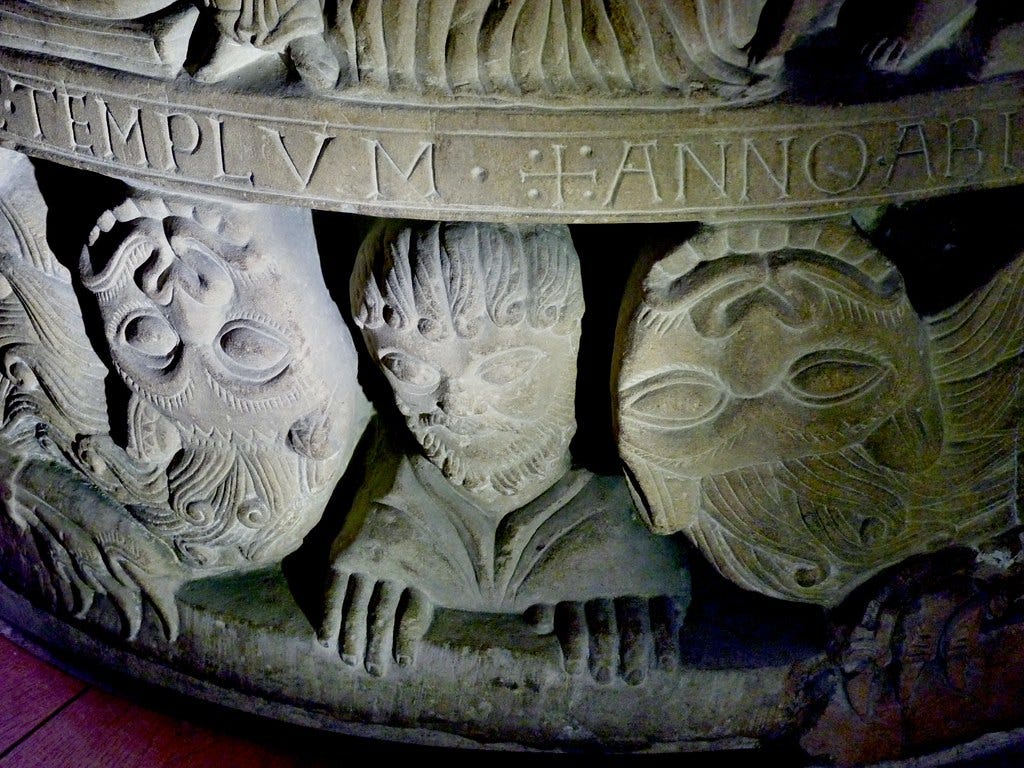
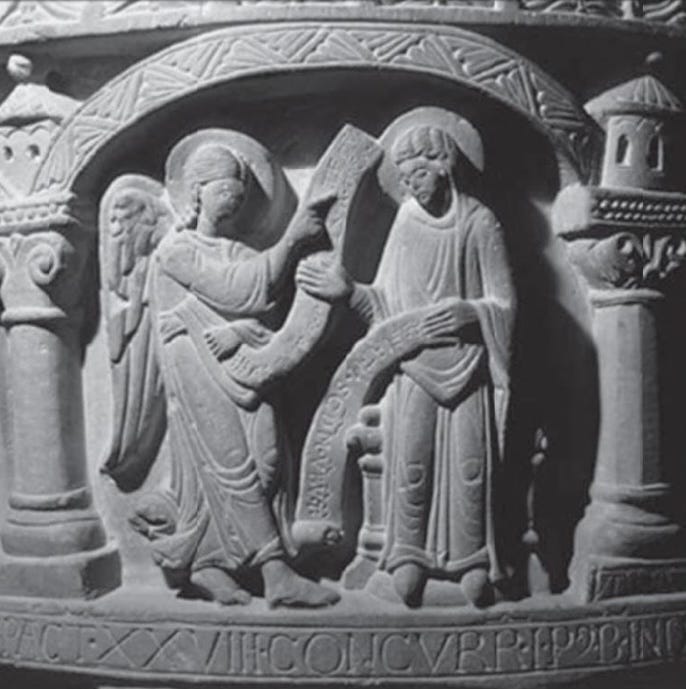
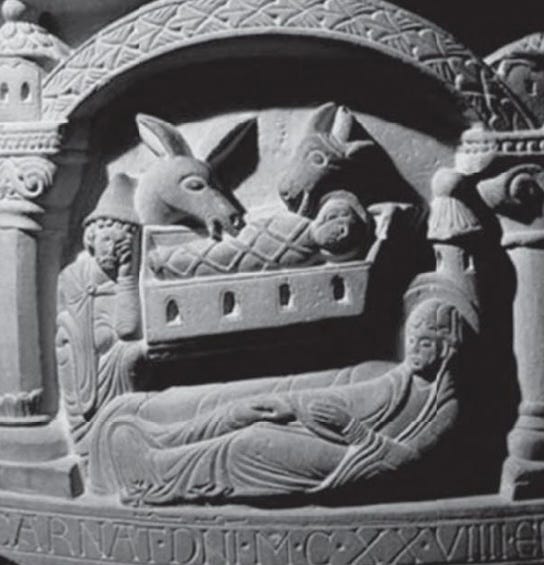
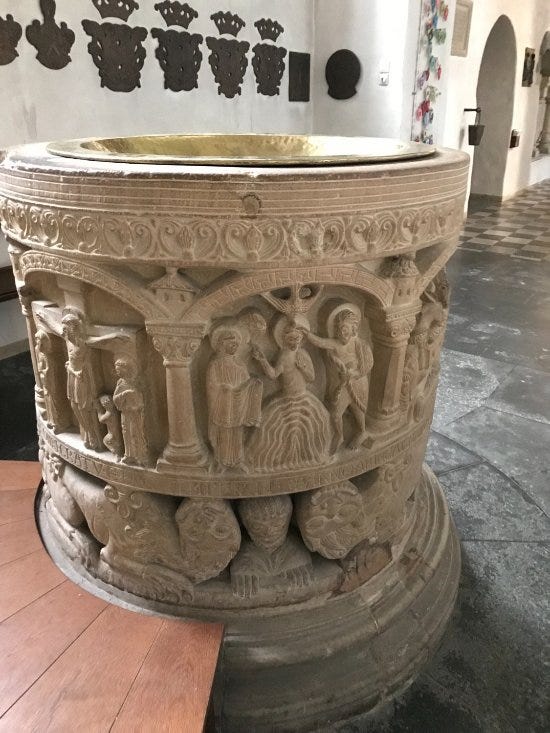


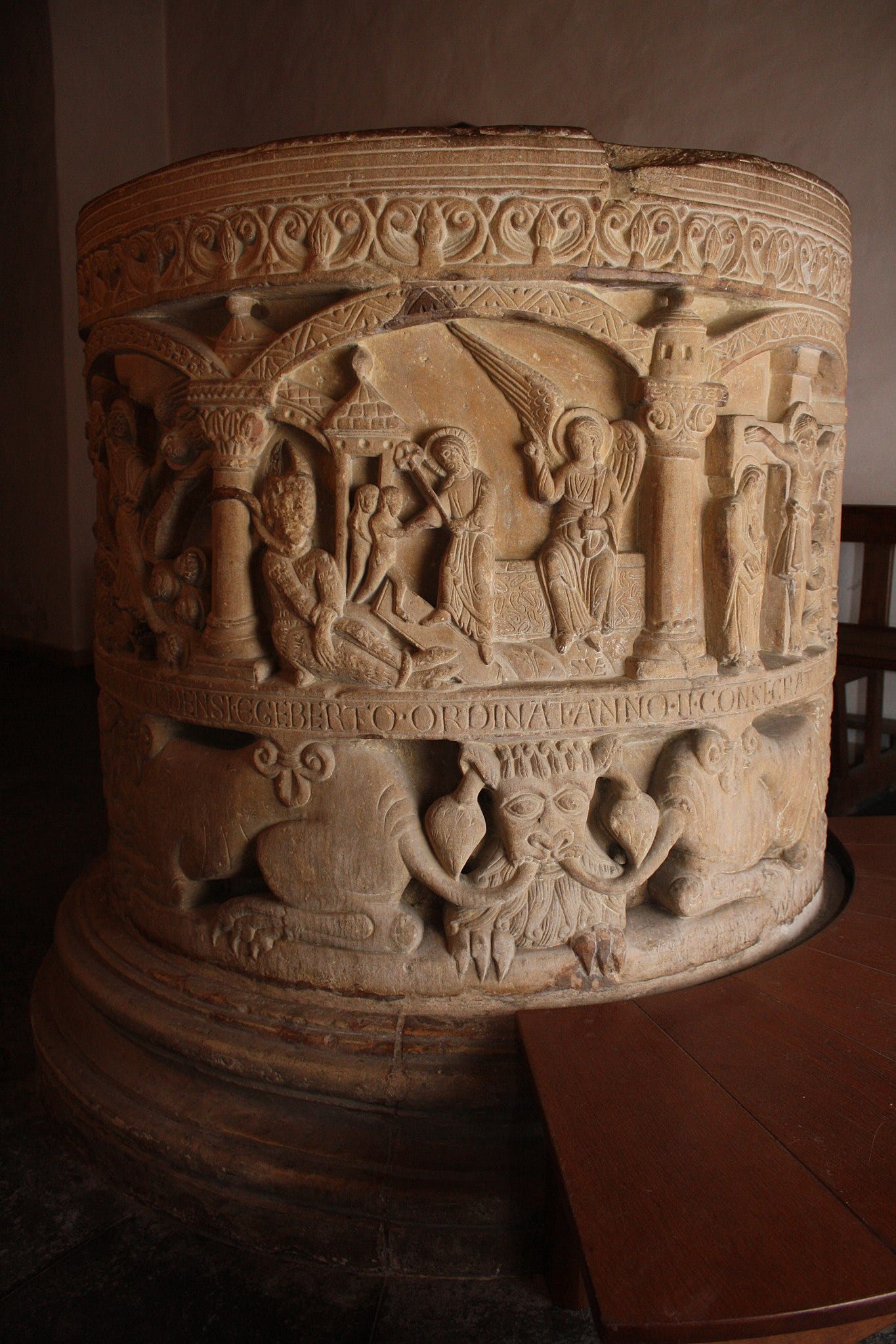




Excellent! You could write a splendid catechism with this format.
I had to laugh, because my first take was as a computer graphic artist and I was thinking you had unearthed a longlost medieval typeface. Glad to see this multifaceted work and especially mandorla expression of Christ the King seated in Glory (and Judgement).
I am working up an initial post to this Substack platform and this article gave me a much needed boost.
Thanks Amelia, great work.